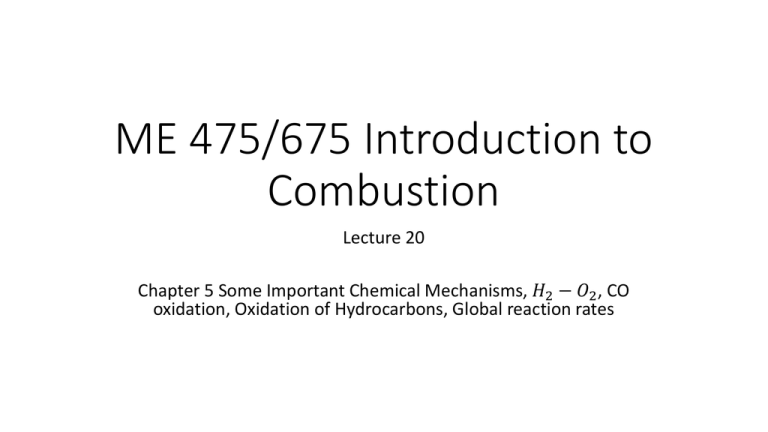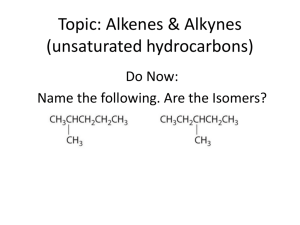ME 475/675 Introduction to Combustion
advertisement

ME 475/675 Introduction to Combustion Lecture 20 Chapter 5 Some Important Chemical Mechanisms, 𝐻2 − 𝑂2 , CO oxidation, Oxidation of Hydrocarbons, Global reaction rates Announcements • HW 7, Due Monday, 10/12/15 • College Distinguished Lecture • Tesla’s JB Straubel to speak about Nevada’s clean energy future • Sunday, October 11, 2015 • 5 pm posters; 6 pm Lecture • http://www.unr.edu/nevada-today/news/2015/jb-straubel-to-speak-at-university HW 7 hints • X2 • H2 / O2 reaction • Carefully apply steady state approximations • 4.16: • NO formation • you’ve already done part A 𝑑 𝑁𝑂 • = 2𝑘1𝑓 𝑂 𝑒𝑞 𝑁2 𝑒𝑞 , so 𝑁𝑂 = 2𝑘1𝑓 𝑂 𝑒𝑞 𝑁2 𝑑𝑡 • Use equilibrium constant to find backward rate 𝑒𝑞 𝑡 • 4.18 • CO combustion • Find characteristic time (can assume one reactant is much more plentiful than other) • 4.19 • Use TPEQUIL to find equilibrium NO mole fraction for each conditions and compared to the amount calculated at 10 ms. Follow directions Chapter 5 Some Important Chemical Mechanisms • Can be very complex, and is a topic of current research, so changing with time • The 𝐻2 − 𝑂2 system, • Page 149-140 lists 20 reactions (40 when reversed) • Initiating, Reactions 1 and 2 • Create 𝐻 and 𝐻𝑂2 radicals • Reactions involving O, H and OH: • Chain reactions: 3-6 (create 𝑂𝐻, 𝑂 𝑎𝑛𝑑 𝐻) • Chain terminating (ter-molecular) 7-10 • Reactions involving 𝐻𝑂2 (hydroperoxy) and 𝐻2 𝑂2 (hydrogen peroxide) • • • • High pressure Reactions 11-14 form 𝐻𝑂2 and then OH, O Reactions 15-16 form 𝐻2 𝑂2 and O Reactions 17-20 consume 𝐻2 𝑂2 , H and OH Explosive limit dependence on pressure and pressure Explosive No Explosion, 11 destroys H atoms Explosive Radicals not destroyed by walls (reactions 3-6) No Explosion, Walls Destroy Radicals CO oxidation • This is important since hydrocarbon (𝐶𝑥 𝐻𝑦 ) combustion has 2 main steps • 𝐶𝑥 𝐻𝑦 + 𝑂2 → 𝐶𝑂 + ⋯ • 𝐶𝑂 + 𝑂2 → 𝐶𝑂2 + ⋯ • This second step is “slow” unless 𝐻2 or 𝐻2 𝑂 are present (these molecules help produce 𝑂𝐻) • If 𝐻2 𝑂 is the primary 𝐻 containing species • • • • 𝐶𝑂 + 𝑂2 → 𝐶𝑂2 + 𝑂 𝑂 + 𝐻2 𝑂 → 𝑂𝐻 + 𝑂𝐻 𝐶𝑂 + 𝑂𝐻 → 𝐶𝑂2 + 𝐻 𝐻 + 𝑂2 → 𝑂𝐻 + 𝑂 (slow but produces needed 𝑂, initiator of chain) (produces needed 𝑂𝐻) (key producer of 𝐶𝑂2 , needs 𝑂𝐻) (produces more 𝑂𝐻) • If 𝐻2 is present • 𝑂 + 𝐻2 → 𝑂𝐻 + 𝐻 • 𝑂𝐻 + 𝐻2 → 𝐻2 𝑂 + 𝐻 (These lead to 𝐻𝑂2 formation, see 𝐻2 − 𝑂2 system) • 𝐶𝑂 + 𝐻𝑂2 → 𝐶𝑂2 + 𝑂𝐻 Oxidation of Hydrocarbons • Alkanes (or Paraffins) • Saturated, straight-chain or branching-chain, singlebonded hydrocarbons, 𝐶𝑛 𝐻2𝑛+2 • Discuss Higher Alkanes 𝑛 ≥ 3 • Discuss 𝑛 = 1 and 2 (methane 𝐶𝐻4 , ethane 𝐶2 𝐻6 ), later • Three step process • 𝑂 𝑎𝑛𝑑 𝐻 attach fuel (remove H from fuel) • Produces Alkenes (𝐶𝑛 𝐻2𝑛 , double carbon bonds) 𝐻 and water • Alkenes oxidize • Produces 𝐶𝑂 𝑎𝑛𝑑 𝐻2 (all is converted to Water) • 𝐶𝑂 burns (𝐶𝑂 + 𝑂𝐻 → 𝐶𝑂2 + 𝐻 ) • Nearly all the heat release occurs in this step Mole Fraction and Temperature versus Location (time) • Propane 𝐶3 𝐻8 in air • 𝐶3 𝐻8 mole fraction decreases with distance (time) • Alkenes (𝐶3 𝐻6 , 𝐶2 𝐻4 ), 𝐻2 and CO increase with distance, reach a maximum and drop off • The temperature rises significantly at locations where the CO is being consumed (heat release) and 𝐶𝑂2 is being produced • Minor species (some oxygenated) increase then decrease More detailed 8-step process (I. Glassman) 1. Break C-C bond (weaker than C-H bonds) 1. 𝐶3 𝐻8 + 𝑀 → 𝐶2 𝐻5 + 𝐶𝐻3 + 𝑀 2. Create alkenes (olifins?) by H-atom abstraction 1. 𝐶2 𝐻5 + 𝑀 → 𝐶2 𝐻4 + 𝐻 + 𝑀 2. 𝐶𝐻3 + 𝑀 → 𝐶𝐻2 + 𝐻 + 𝑀 3. 𝐻 atoms help produce pool of radicals 1. 𝐻 + 𝑂2 → 𝑂𝐻 + 𝑂 4. Radicals attack fuel 1. 𝐶3 𝐻8 + 𝑂𝐻 → 𝐶3 𝐻7 + 𝐻2 𝑂 2. 𝐶3 𝐻8 + 𝐻 → 𝐶3 𝐻7 + 𝐻2 3. 𝐶3 𝐻8 + 𝑂 → 𝐶3 𝐻7 + 𝑂𝐻 5. New hydrocarbon radicals decay into alkenes via H-atom abstraction 1. 𝐶3 𝐻7 + 𝑀 → 𝐶3 𝐻6 + 𝐻 + 𝑀 2. Follows b-session rule b-session rule • Radical site: • site of unpaired electron • Strengthens the adjacent bond(s) but weakens the next bond • The C-C or C-H bond that breaks will be one bond away from the radical site • Two possibilities (as seen in temporal evolution two slides back): • 𝐶3 𝐻7 + 𝑀 → 𝐶3 𝐻6 + 𝐻 + 𝑀 or • 𝐶3 𝐻7 + 𝑀 → 𝐶2 𝐻4 + 𝐶𝐻3 + 𝑀 Continuation of 8-step process 6. O-atoms attach olefins from steps 2 and 5 1. 𝐶3 𝐻6 + 𝑂 → 𝐶2 𝐻5 + 𝐻𝐶𝑂 (formyl radical) 2. 𝐶3 𝐻6 + 𝑂 → 𝐶2 𝐻4 + 𝐻2 𝐶𝑂 (formaldehyde) 7. Methyl radicals (𝐶𝐻3 ), formaldehyde (𝐻2 𝐶𝑂) and Methylene (𝐶𝐻3 ) oxidize 1. Produces 𝐶𝑂 8. 𝐶𝑂 oxidizes to produce 𝐶𝑂2 Global and Quasi-global mechanisms rates • Empirical • 𝐶𝑥 𝐻𝑦 + 𝑥 + 𝑦 4 𝑂2 𝑘𝐺 𝑦 2 𝑥𝐶𝑂2 + 𝐻2 𝑂 • stoichiometric mixture with 𝑂2 , not air • 𝑑 𝐶𝑥 𝐻𝑦 𝑑𝑡 = −𝐴𝑒𝑥𝑝 𝐸𝑎 𝑅𝑢 𝑇 𝐶𝑥 𝐻𝑦 𝑚 𝑂2 𝑛 = 𝑔𝑚𝑜𝑙𝑒 𝑐𝑚3 𝑠 • Page 157, Table 5.1: 𝐴, 𝐸𝑎 𝑅𝑢 , 𝑚 𝑎𝑛𝑑 𝑛 for different fuels • These values are based on flame speed data fit (Ch 8) • In Table 5.1 units for 𝐴 = • However, we often want 𝐴 • 1 𝑔𝑚𝑜𝑙𝑒 1−𝑚−𝑛 𝑠 𝑐𝑚3 • 𝐴 1 𝑘𝑚𝑜𝑙𝑒 1−𝑚−𝑛 𝑠 𝑚3 𝑔𝑚𝑜𝑙𝑒 1−𝑚−𝑛 − 𝑚+𝑛 𝑔𝑚𝑜𝑙𝑒 𝑔𝑚𝑜𝑙𝑒 𝑐𝑚3 = 𝑐𝑚3 𝑠 𝑐𝑚3 𝑠 1−𝑚−𝑛 1 𝑘𝑚𝑜𝑙𝑒 in units of 𝑠 𝑚3 𝑘𝑚𝑜𝑙𝑒 1000 𝑔𝑚𝑜𝑙𝑒 =𝐴 1−𝑚−𝑛 100 𝑐𝑚 3 𝑚 1 𝑔𝑚𝑜𝑙𝑒 1−𝑚−𝑛 𝑠 𝑐𝑚3 = 1 𝑔𝑚𝑜𝑙𝑒 1−𝑚−𝑛 𝑠 𝑐𝑚3 Usually Want These Units 1000 1−𝑚−𝑛 = 1 𝑘𝑚𝑜𝑙𝑒 1−𝑚−𝑛 𝑠 𝑚3 10001−𝑚−𝑛 = 𝐴 𝑇𝑒𝑥𝑡𝑏𝑜𝑜𝑘 10001−𝑚−𝑛 Given in Table 5.1, p. 157 Other empirical models • Multistep models • Text pp. 157-8 • Fuel Surrogates • Text pp. 158-9 Methane Combustion, 𝐶𝐻4 • 325 steps, 53 species • Text pp. 160-7 • Two pathways • High temperature • Low temp (< 1500 K) Oxides of Nitrogen Formation • Important contribution to air pollution • 4 mechanisms • • • • Thermal (Zeldovich): High temperature for a range of Φ Fenimore (or prompt): Fuel Rich Φ > 1 𝑁2 𝑂-intermediate (very lean Φ < 1 and low temperature) NNH: new • Thermal • • • • 𝑂 + 𝑁2 → 𝑁𝑂 + 𝑁 𝑁 + 𝑂2 → 𝑁𝑂 + 𝑂 𝑁 + 𝑂𝐻 → 𝑁𝑂 + H Coupled with fuel combustion through 𝑂2 , 𝑂 𝑎𝑛𝑑 𝑂𝐻. Chapter 6 Coupling Chemical and Thermal Analysis of Reacting systems • Four simple systems, p 184 • Constant pressure and fixed Mass Reactor • Constituents (reactants and products, 𝑖), 𝑖 = 1,2, … 𝑁 • P and m constant • Find as a function of time, t • 𝑇 (energy) • 𝑖 (species generation) 𝑚 • 𝑉 = , 𝑛𝑒𝑒𝑑 𝜌 (state, mixture) 𝜌 • Assume we know 𝑑𝑖 𝑑𝑡 = 𝜔𝑖 = 𝑓𝑛 𝑖 • From chemical Kinetics • Energy 𝑄 − 𝑊 = 𝑑𝑢 𝑚 𝑑𝑡



